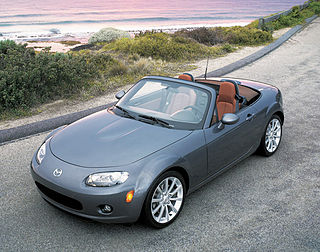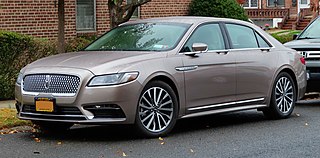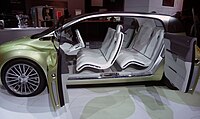
Minivan is a car classification for vehicles designed to transport passengers in the rear seating row(s), with reconfigurable seats in two or three rows. The equivalent classification in Europe is MPV or M-segment.

A station wagon or estate car is an automotive body-style variant of a sedan with its roof extended rearward over a shared passenger/cargo volume with access at the back via a third or fifth door, instead of a trunk/boot lid. The body style transforms a standard three-box design into a two-box design—to include an A, B, and C-pillar, as well as a D-pillar. Station wagons can flexibly reconfigure their interior volume via fold-down rear seats to prioritize either passenger or cargo volume.

A convertible or cabriolet is a passenger car that can be driven with or without a roof in place. The methods of retracting and storing the roof vary among eras and manufacturers.

A hatchback is a car body configuration with a rear door that swings upward to provide access to the main interior of the car as a cargo area rather than just to a separated trunk. Hatchbacks may feature fold-down second-row seating, where the interior can be reconfigured to prioritize passenger or cargo volume.

A coupe or coupé is a passenger car with a sloping or truncated rear roofline and two doors.

The Lincoln Town Car is a model line of full-size luxury sedans that was marketed by the Lincoln division of the American automaker Ford Motor Company. Deriving its name from a limousine body style, Lincoln marketed the Town Car from 1981 to 2011, with the nameplate previously serving as the flagship trim of the Lincoln Continental. Produced across three generations for thirty model years, the Town Car was marketed directly against luxury sedans from Cadillac and Chrysler.

Coupé de ville — also known as town car or sedanca de ville — is a car body style produced from 1908 to 1939 with an external or open-topped driver's position and an enclosed compartment for passengers. Although the different terms may have once had specific meanings for certain car manufacturers or countries, the terms are often used interchangeably.

The Lincoln Continental is a series of mid-sized and full-sized luxury cars produced between 1939 and 2020 by Lincoln, a division of the American automaker Ford Motor Company. The model line was introduced following the construction of a personal vehicle for Edsel Ford, who commissioned a coachbuilt 1939 Lincoln-Zephyr convertible, developed as a vacation vehicle to attract potential Lincoln buyers. In what would give the model line its name, the exterior was given European "continental" styling elements, including a rear-mounted spare tire.
There are many types of car body styles. They vary depending on intended use, market position, location, and the era they were made.

Delta was a General Motors compact front-wheel drive automobile and crossover SUV platform, originally developed by Opel Group. Delta was a successor to the Opel T platform; it also replaced J platform and the Z platform used by the Saturn S-Series. The platform debuted in the 2003 Saturn Ion. Vehicles of this platform generally carry the letter "A" in the fourth character of their VINs.

The Geneva International Motor Show is an annual auto show held in March in the Swiss city of Geneva.

The Opel Meriva is a car manufactured and marketed by the German automaker Opel on its Corsa platform, from May 2003 until June 2017 across two generations. Described as a mini MPV, it was marketed as the Vauxhall Meriva in the United Kingdom, while in Latin America, the first generation model was marketed as the Chevrolet Meriva.

The International Motor Show Germany or International Mobility Show Germany, in German known as the Internationale Automobil-Ausstellung, is one of the world's largest mobility trade fairs. It consists of two separate fairs, that subdivided in 1991. While the IAA Mobility displays passenger vehicles, motorcycles and bikes, the IAA Transportation specializes in commercial vehicles. Before the separation, the show was held solely at the Messe Frankfurt.

The trunk or boot of a car is the vehicle's main storage or cargo compartment, often a hatch at the rear of the vehicle. It can also be called a tailgate.
A glossary of terms relating to automotive design.

The configuration of a car body is typically determined by the layout of the engine, passenger and luggage compartments, which can be shared or separately articulated. A key design feature is the car's roof-supporting pillars, designated from front to rear of the car as A-pillar, B-pillar, C-pillar and D-pillar.

A car door is a type of door opening, typically hinged on its front edge, but sometimes attached by other mechanisms such as tracks, for entering and exiting a vehicle. Doors most often integrate side windows for visibility from inside the car and can be locked to secure the vehicle.

Quarter glass on automobiles and closed carriages may be a side window in the front door or located on each side of the car just forward of the rear-facing rear window of the vehicle. Only some cars have them. In some cases, the fixed quarter glass may set in the corner or "C-pillar" of the vehicle. Quarter glass is also sometimes called a valence window.

The Citroën Ami is a two-passenger electric quadricycle marketed by the French manufacturer Citroën, produced from 2020 and marketed from June 2020. The vehicle was developed by Groupe PSA in collaboration with Altran, an engineering consultancy subsidiary of Capgemini as a turnkey program.


























